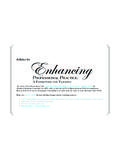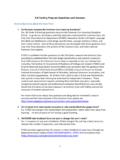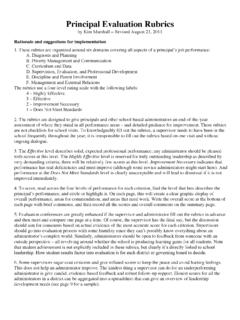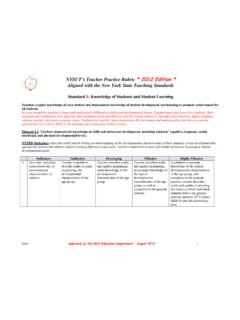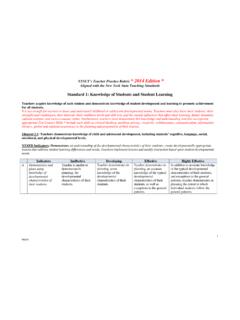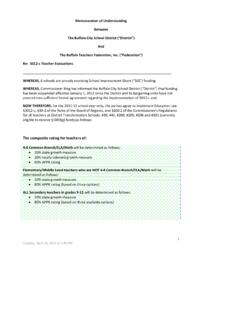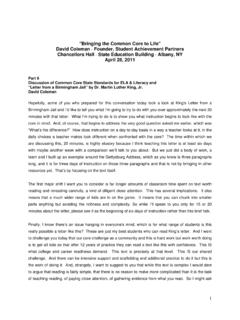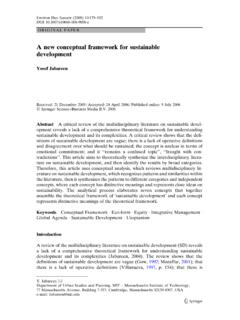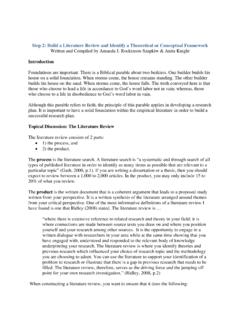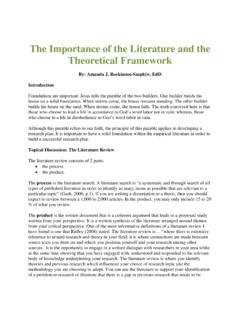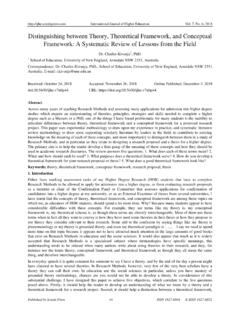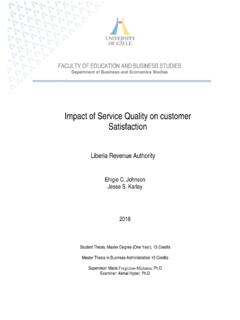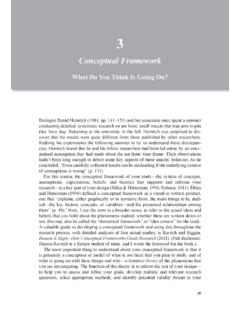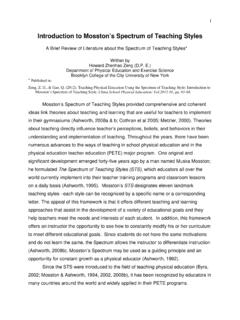Transcription of Framework for Teaching Evaluation Instrument
1 Framework for Teaching Evaluation Instrument The Framework for Teaching is designed to help districts promote a common definition and understanding of excellence in Teaching , one that everyone teachers, administrators, and the larger community can easily comprehend. Charlotte Danielson developed the Framework for Teaching Evaluation Instrument in 2011 and further enhanced it in 2013 to facilitate evaluations, and consequently has enhanced the language of her original Framework throughout to be as clear as possible. In addition, beginning with the 2011 Edition, she added critical attributes and possible examples of Teaching at each performance level for each component. The definitions and expectations for each domain and component within each performance level are clear and precise, intentionally designed to be understood by all, regardless of role, position, or experience level.
2 The 2013 Edition In addition to tighter language to assist evaluators in making clear distinctions between performance levels, the 2013 Edition now includes specific language around the instructional implications of the Common Core State Standards. The Framework for Teaching has always been grounded in student learning and included the big concepts of the Common Core. Now the 2013 Edition includes specific rubric language, critical attributes, and Teaching and learning examples that help schools and districts identify instruction that leads to student learning in the context of the Common Core. An overview of how the Framework has evolved since 1996 and over the course of the Evaluation Instrument , 2011 and 2013 Editions, is provided in the table on the following page. Teachscape Exclusive License Any local education agency (LEA) or individual may download and use paper versions of the Framework for Teaching Evaluation Instrument , 2011 and 2013 Editions.
3 However, Charlotte Danielson has granted Teachscape the exclusive digital rights to the 2011 and 2013 Editions. Our shared commitment to faithfully implementing the Framework for Teaching as part of a constructive, reflective Evaluation process means Teachscape s is the only software platform that Charlotte Danielson has approved, endorsed, and authorized to be used in conjunction with the Evaluation Instrument , 2011 and 2013 Editions. Teachscape and Charlotte Danielson share a dedication to build fair, transparent, and educative Evaluation systems that are designed to support teachers and enhance Teaching practice, and we look forward to continuing this important work in the years to come. Evolution of the Framework for Teaching (FFT) Version 1996 FFT 2007 FFTFFT Evaluation Instrument 2011 Edition 2013 Edition Structure 4 domains, 22 components, 76 elementsNeeds addressed Outgrowth of research compiled by ETS for PRAXIS III assessment for state licensing of new teachers Captures the spectrum of Teaching skills at all levels of experience and expertise Incorporated additional research Added recognition of state curriculum standards Higher stakes, higher expectations require increased accuracy of observations with increasingly limited resources Incorporates learnings from MET project.
4 Language tightened in 2011 for use in MET project, and further tightened in 2013 Incorporates instructional implications of the Common Core State Standards (2013 Edition) Defining characteristics Frameworks for non classroom specialists added (librarians, nurses, counselors) Five components renamed, mostly to clarify language 1f and 3d significant: 1f assigned the design of student assessments to Domain 1 (Planning & Prep) and Using Assessment in Instruction to Domain 3 (Instruction) Rubrics now written at component levelrather than element level. Easier to use in Evaluation now based on 22 components rather than 76 elements. Critical attributes, or essential characteristics of Teaching , added for each level of performance within each component to help observers score with increased accuracy. Examples of Teaching and learning at each level for each component added to illustrate meaning of rubrics language and what practice might look like in a range of settings; not meant to be all encompassing.
5 Even clearer rubric language and descriptions for each performance level within each component to help observers make tighter distinctions between performance levels. Instructional implications of the Common Core State Standards. Additions to Domain 1 (mostly in examples) support curriculum and assessment. Additions and refinements in Domains 2 and 3 include more specific descriptions and critical attributes that support the primary Common Core themes of: Academic language Argumentation Student strategies CHARLOTTE DANIELSONTHE Framework FOR TEACHING2013 EDITIONEVALUATION INSTRUMENTCHARLOTTE DANIELSONTHE Framework FOR TEACHING2013 EDITIONEVALUATION INSTRUMENT1 TABLE OF CONTENTSI ntroduction ..3 Domain 1 ..7 Domain 2 ..33 Domain 3 ..57 Domain 4 ..852 INTRODUCTION3 The Framework for Teaching identifies those aspects of a teacher s responsibilities that have been documented through empirical studies and theoretical research as promoting improved student learning.
6 While the Framework is not the only possible description of practice, these responsibilities seek to define what teachers should know and be able to do in the exercise of their 1996 EditionFirst published by ASCD in 1996, Enhancing Professional Practice: A Framework for Teaching was an outgrowth of the research compiled by Educational Testing Service (ETS) for the development of Praxis III: Classroom Performance Assessments, an observation-based Evaluation of first-year teachers used for the purpose of licensing. The Framework extended this work by examining current research to capture the skills of Teaching required not only by novice teachers but by experienced practitioners as well. The Framework quickly found wide acceptance by teachers, administrators, policymakers, and ac-ademics as a comprehensive description of good Teaching , including levels of performance un-satisfactory, basic, proficient, and distinguished for each of its 22 2007 EditionThe 2007 edition of the Framework , also published by ASCD as Enhancing Professional Practice: A Framework for Teaching , incorporated several important enhancements.
7 Most importantly, it re-flected educational research that had been conducted since 1996; this was fully described in its Appendix, The Research Foundation. Moreover, the 2007 edition included frameworks for non-classroom specialist positions, such as school librarians, nurses, and counselors. These individ-uals, while typically part of the teacher bargaining unit in a school district, have very different responsibilities from those of classroom teachers. Therefore, they need their own frameworks, tai-lored to the details of their work. These frameworks were written to reflect the recommendations of their professional organizations, such as the American Association of School Librarians, but organized according to the same structure as that of the Framework for Teaching : Planning and Preparation, The Environment, Delivery of Service (the equivalent of Instruction), and Professional Responsibilities.
8 The 2007 edition of the Framework for Teaching retained the architecture of the 1996 edition; in both cases, the complex work of Teaching is divided into 4 domains and 22 components. Furthermore, each component is composed of several smaller elements, which serve to further define the com-ponent. A few of the components were renamed: 1c: Selecting Instructional Goals was changed to Setting Instructional Outcomes. 1f: Assessing Student Learning was revised to Designing Student Assessments. 3a: Communicating Clearly and Accurately was revised to Communicating with Students. 3d: Providing Feedback to Students was altered to Using Assessment in Instruction. 4d: Contributing to the School and District was changed to Participating in a Professional Community. 4 INTRODUCTIONMost of these revisions were simple clarifications to the language.
9 In the case of 4d, for example, the original name implied to some people that Contributing to the School and District was an ad-ditional responsibility, not integral to the work of Teaching ; whereas the new name, Participating in a Professional Community, suggests that it is an essential professional , the revisions to 1f and 3d were significant: the 2007 edition clearly assigned the design of student assessments (1f) to Domain 1: Planning and Preparation, and 3d: Using Assessment in Instruction to Domain 3: Instruction. These distinctions were not as apparent in the 1996 2011 EditionIn 2009, the Bill and Melinda Gates Foundation embarked on the large research project, Measures of Effective Teaching (MET), which entailed the video capture of over 23,000 lessons, analyzed according to five observation protocols, with the results of those analyses (together with other measures) correlated to value-added measures of student learning.
10 The aim of the study was to determine which aspects of a teacher s practice were most highly correlated with high levels of student Framework for Teaching was one of the models selected for this large-scale study, which in-volved the (online) training and certification of hundreds of observers for the purpose of rating the quality of Teaching in the lessons. In order to fulfill this obligation, it became necessary to supply additional tools to aid in the training of observers, so that they could make accurate and consistent judgments about Teaching practice as demonstrated in the large numbers of videotaped lessons. The following additional tools included: Rubric language tighter even than that of the 2007 edition of the Framework for Teaching . Furthermore, the levels of performance in the 2011 revision are written at the component, rather than the element, level.
